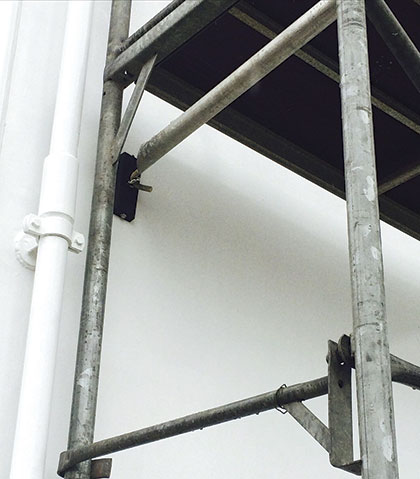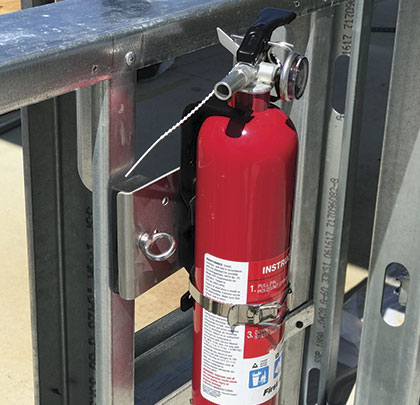Following the energy crisis in the 1970’s, the Danish Industry and Government set a goal to become the global leader in wind power technologies, hereby creating todays’ energy independence and a strong engineering and research-minded industry. With time, continuous product development, trial and error, many of these engineered solutions have evolved, through mergers and acquisitions, into several large multinational wind turbine brands like Vestas, Siemens, and General Electric.
Today, the above mentioned companies deploy their wind turbine technologies on a global scale. In many ways, you can define today’s wind industry as a multibillion dollar niche market as the construction projects have grown in capacity size to match the capacity size of conventional coal, gas, or nuclear power plants.

Featured Image: The Engiso V-Mag 70 temporarily holds a fire extinguisher in the proper place near the work being done.
Above: The Engiso V-Mag 340 is used as a temporary hold for scaffolding during construction. V-Mag 70 = 150 lbs. pull force, V Mag 340 = 750 lbs. pull force.
CHALLENGES FOR CONSTRUCTION
The construction challenges in the wind industry is that of safety first, high quality, repeated construction, constant evolvement in tower and foundation designs, crane height and capacity, availability of qualified people, weather delays and cost-out through the value chain and during the construction season, speed, agility, and preparedness. Many contracts and contractors are subjected to tremendous cost-out and time pressure to get the job done faster, with less labor and liquidated damages hanging over the head(s) in case of delays. In many ways, the wind industry closely resembles the general construction industry, but this is where 30+ years of construction innovation comes in along with an aligned value chain driven to make the wind power industry more competitive.
Per American Wind Energy Association (AWEA) and the US Department of Energy (DOE), the wind industry has been able to accomplish year over year cost of energy reduction of more than 90 percent since the 1980’s to today. Wind power is now a competitive conventional energy source, even with the removal of the Production Tax Credit (PTC) per AWEA.
MAGNETIC SOLUTION
Looking at cost-out within the tower construction itself, one may say, “I just need to weld the components together; it is a steel tower” and that is an amicable, common, and conventional way of thinking. This was also the case in the wind industry some years ago. However, through cost-out processes and clever engineering, the wind industry now saves millions of dollars each year by using Engiso V-Mag’s and alike to permanently install climbing ladders, working platforms, light fixtures, cable trays on the inside of the tower wall, as well as for the installation of communication equipment like radar, WIFI antenna, and satellite dishes outside of the steel wind turbines tower.
Why is that and how is that possible?
A typical wind tower sees more vibrations than commercial airliner over its lifetime. This is due to wind load, vortex shedding, braking, and speed of rotor. By reducing the amounts of weld points on the steel tower, it is possible to super optimize the tower structure. Imagine the equivalent of a fully loaded semitrailer, sitting, rotating, and swaying on top of a 400-foot steel tower with a material thickness ranging from ½ inch at the top to 2 inches at the base. The tower is critical for the success of the installation with an expected lifetime of 20 years.
TECHNOLOGY SAVES COST
Industry professional engineers and procurement managers alike have found that by using an Engiso V-Mag 340 or a multiple of V-Mag 340 ganged together, they can super optimize the steel wall thickness of wind towers as they no longer need to accommodate for the 100’s of full-weld penetrations normally affecting the structural integrity of the tower, as well as time to weld and inspect such welds.
The bottom line effect can be accomplished when you lower the material cost, reduce labor installation, reduced cost of transportation, and are able to use smaller crane capacity for the erection process.
For temporary use, it is common practice in the wind industry to use the smaller Engiso V-Mag 70 as a “second hand” during the rebar and concrete foundation construction process. Instead of adding or allocating man-hours to “place”/“hold” the rebar and mesh in place prior to actual concrete pour, the Engiso V-Mag 70 becomes a trusted and helpful “colleague” as a “magnetic rebar chair.” This yields a labor saving in an already competitive market for repeat foundation installations.
DEPLOYED IN CONSTRUCTION
With the creativity of modern engineering, architects, and hardworking construction workers, the challenges and solutions developed in the wind industry are now being applied in other construction industries.
Support and placement of temporary scaffolding and hand rails at a construction site are gravitating towards magnetic solutions that can be easily attached and removed afterwards without damaging or otherwise having to grind down old welds and refurbish the metal structure it was conventionally attached to.
THE USES ARE MANY
Temporary placement of fire extinguishers, first aid, AED equipment at the correct height and in close proximity to where the work is actually performed versus placement of safety critical items on the floor, behind the scissor lift, and in buckets, where no one can find it in case of an accident. Removal of tripping hazards by running extension cords off the ground with easy to move magnetic cable holders. Placement of wire mesh, rebar chairs and allowing for curved, concave, and other architecturally challenged forms to be held in place during the pour. Think also of temporary placement of condition monitoring devices, security cameras and signage; temporary attachment points for tools, tool lanyard and buckets; temporary attachment of fire curtains, plastic sheets, and netting; plus in under water construction or in wet areas where conventional welding or electrocution poses a safety risk.
About the Author:
Kent Pedersen is managing partner at Engiso, an organization of engineers and project managers with several years of know-how from the extreme construction industry environment. Engiso’s V-Mag solution is a great example of listening to its customer needs. Customers asked for fast install time onto steel and corrosion resistance. Engiso answered with “rubber coated neodymium magnets with mechanical interface that does not interfere with communication equipment.” Pedersen can be reached at 414.331.1345 or kp@engiso.com. For more, visit www.engiso.com.
_________________________________________________________________________
Modern Contractor Solutions, January 2018
Did you enjoy this article?
Subscribe to the FREE Digital Edition of Modern Contractor Solutions magazine.



